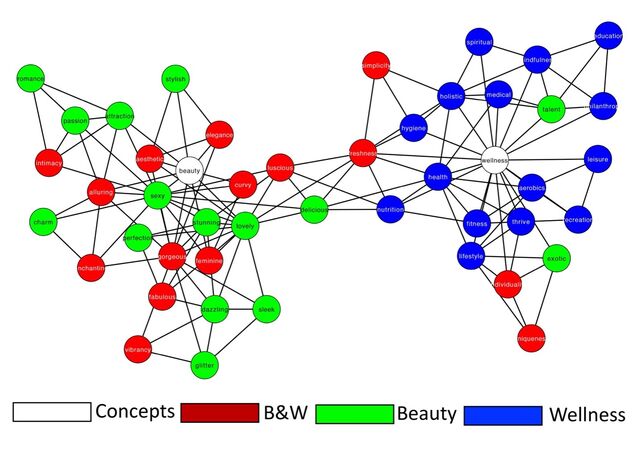Gender
How Do People Think About Beauty and Wellness?
Network science can help us understand these concepts.
Posted August 16, 2021 Reviewed by Devon Frye
Key points
- Free associations to single words can be used to create semantic networks that reveal how people think about concepts like beauty and wellness.
- Older people have more granular notions of beauty and wellness than younger people.
- Women are more organized than men in their ideas of beauty and wellness and bridge both ideas with reference to appearance and individuality.

This post was co-authored by Yoed N. Kenett
People are preoccupied with ideas surrounding beauty and wellness. The commercial world is not oblivious to this preoccupation and often links beauty to wellness.
According to the Global Wellness Institute (GWI, 2018), in 2017 beauty was the largest commercial sector at a billion dollars of a 4.2 trillion dollar wellness market. People avidly consume beauty- and health-related products. Fitness centers and beauty salons, vitamins and supplements, self-help books, wellness blogs, activity holidays, silent retreats, all attest to the popularity of wellness practices.
But underlying these group behaviors, what do we mean by the terms beauty and wellness? Examining these elusive concepts based on the term’s associations can provide insight into how people in the aggregate conceptualize beauty and wellness.
Network Science
Network science is based on mathematical graph theory and offers quantitative ways to represent complex systems as graphs or networks. It is now widely used across all fields of science, including transportation routes, social media, biological systems such as the brain, and cognition.
In studying cognition, network science approaches allow investigators to chart a web-like graph of words associated with specific concepts by crowd-sourcing people’s responses and opinions to target words. Quantifying these associations gives us maps or semantic networks of meaning that can be depicted spatially. This approach to meaning taps into how people naturally structure concepts in their minds.
Using semantic network analysis, we recently published our findings (Kenett, Ungar, and Chatterjee, 2021) in response to the questions: 1) What words surround beauty and wellness? 2) How are beauty and wellness linked to each other? 3) Does the way people think about beauty and wellness change across different generations (Baby Boomers, Millennials, Generation X, and Generation Z)? And, as an exploratory question, 4) Do men and women think about beauty and wellness differently?
We used computational linguistic methods to identify candidate terms (using 100 million words from a decade of published Google News) that relate to the concepts beauty and wellness (top 15 most frequent terms for each concept). To examine the relation of beauty and wellness, we identified terms that related to a category that combined both concepts (beauty + wellness, 15 terms). Such computational methods have been used widely in psycholinguistic research as a method to identify category related terms.
We then recruited online participants (N = 454) who approximated Generation Z (GenZ; 20–30 years old), Millennials (Mill; 31–40 years old), Generation X (GenX; 41–50 years old), and Baby Boomers (Boomers; 61–70 years old). From these cohorts, we collected free association responses to these 45 terms as well as to the terms beauty and wellness from our targeted age cohorts to construct semantic networks.
Beauty and Wellness networks
Networks associated with beauty and wellness were surrounded by distinct communities of words. beauty was closely related to elegance, feminine, gorgeous, lovely, sexy, and stylish. These associations, which include physical and cultural notions of beauty, were consistent across generations and sex. Wellness was closely related to aerobics, fitness, health, holistic, lifestyle, medical, nutrition, and thrive across generations and sex. These associations suggest that wellness was conceptualized as active practices that promote health and a sense of human flourishing (Kenett et al., 2021).

Our cohort network analyses revealed that older people were more granular in their thinking about beauty and wellness. Baby Boomers expressed the most distinct communities that also precipitated into many sub-communities. They appeared to have a narrower and more nuanced dissection of these concepts.
Why might we see such effects of age? One possibility is that with more lived experience and accumulation of knowledge, people develop a greater semantic acuity for these ideas. Another possibility is that because of socio-cultural dynamics, older people are increasingly aware of and influenced by stereotypical models of beauty and wellness and do not conceptualize the world as fluidly as younger people.
The semantic neighborhood of beauty for the Millennials and Generation X groups had unique associations that relate to appearance (e.g., attraction, curvy), compared to the two other groups. Furthermore, Baby Boomers were the only group that associated education with beauty. The semantic associations to wellness were similar across the age cohorts, with a few unique associations, such as delicious for Generation Z, education and spiritual for Generation X, individuality and philanthropy for Millennials, and vibrancy for Baby Boomers. Millennials appear to be tuned to social and communal wellness and older people tilt towards their own personal wellness.
Men and women were also subtly different in how they think about these concepts. Women’s ideas of beauty and wellness were more organized than they were for men. Women also expressed a third intermediate and smaller community between the communities of beauty and wellness. This community that bridged beauty and wellness included terms that focused on appearance and individuality (exotic, luscious, delicious, uniqueness, and individuality).
What This Means
People have a shared understanding of the terms beauty and wellness, despite some differences across generations and gender in the structure of this understanding. Semantic network analysis offers a window into the conceptual space occupied by these terms. We find that modern characterizations of both of these concepts reflect physical, mental, and cultural attributes.
Our results indicate that beauty is about being elegant and sexy at the same time; wellness is about being healthy and spiritual at the same time. We find that a core meaning of these two concepts, operationalized by their semantic communities, is stable across age and gender. Older people’s conceptualizations of the two concepts are more distinct and segregated. Women also have more granular sensibilities of these terms and link beauty and wellness explicitly through notions of individuality and appearance.
References
Global Wellness Institute (2018). 2018 Global Wellness Economy Monitor. Miami, FL: The Global Wellness Institute. https://globalwellnessinstitute.org/industry-research/2018-global-wellness-economy-monitor/
Kenett, Y. N., Ungar, L., & Chatterjee, A. (2021). Beauty and wellness in the semantic memory of the beholder. Frontiers in Psychology, 12, 3310. https://doi.org/10.3389/fpsyg.2021.696507
Semantic network with 47 cue words (nodes). Edges denote symmetrical, binary relations between nodes. Colors represent category. Source: Figure by Kenett, Ungar, and Chatterjee / CC BY 4.0



